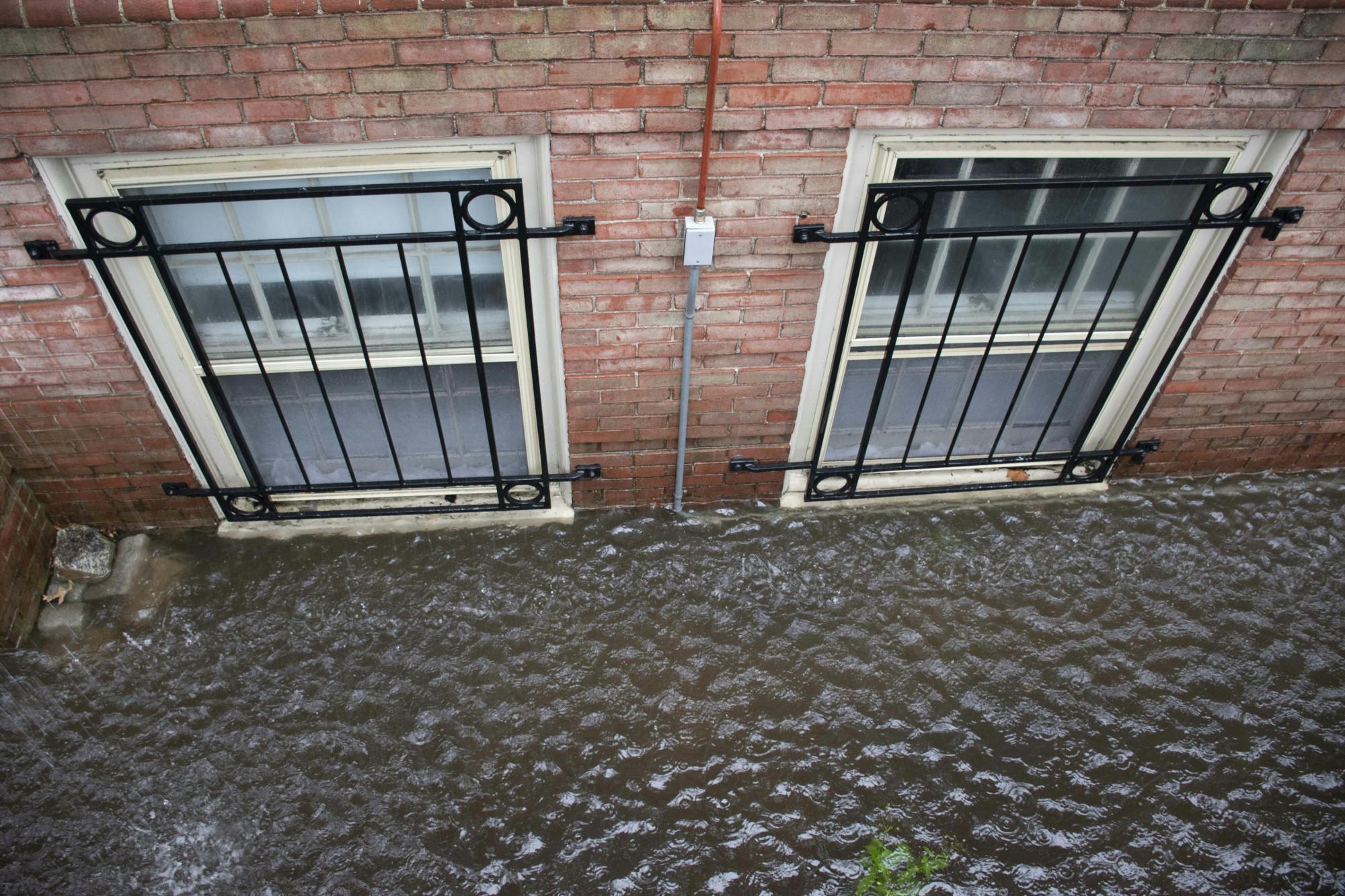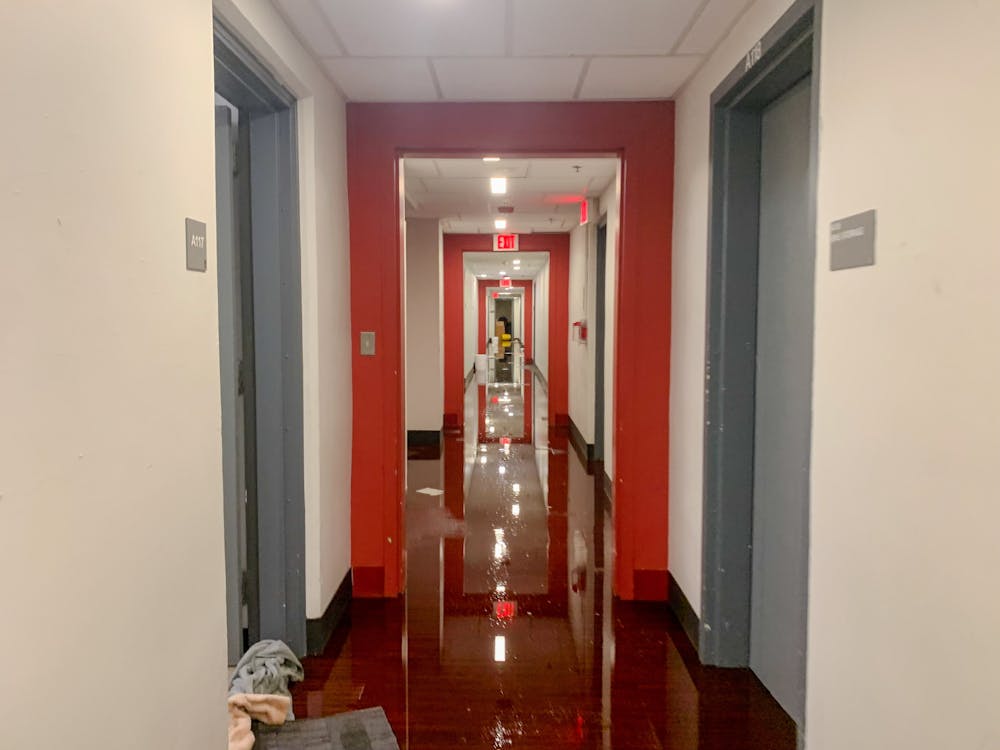Several campus buildings flooded Monday due to heavy rain, displacing roughly 35 first-year students from their rooms.
The Archibald-Bronson dorm saw the most significant flooding, with first-years describing water pouring in through doors and windows and leaking through walls in the basement hallway as the storm went on. Diman, Sears and the Verney-Woolley Dining Hall saw flooding as well, sources told The Herald.
“Seventeen rooms were affected and approximately 35 students were temporarily displaced,” wrote University Spokesperson Brian Clark in an email to The Herald on behalf of the Office of Residential Life, the Department of Facilities Management and the Department of Public Safety.
“I heard some general commotion from outside my door,” said Collin Brown ’26, a resident of the Archibald-Bronson basement. “I turned the corner (and) … the door was just pouring out water.”
Justin Meszler ’26 lives on the second floor of Keeney but was doing laundry in the basement when the flooding began.
“The situation rapidly escalated as more water kept coming in,” Meszler said. “It was really just a frantic team effort of trying to use some sandbags that we found there to block out the water.”
While trying to physically stop the water from coming in, several students called the ResLife and Facilities Management phone numbers but had difficulty getting in touch with staff.
“I called multiple people on the (back of my Brown ID) card,” Brown said. “I guess it (was) Labor Day, so it's understandable that they were out of office.”
My calls were “transferred multiple times,” he added. “It took a really long time for something to happen.”
“Staff from Brown's Facilities Management team and Residential Life offices have been assisting on-site at Archibald-Bronson since late Monday afternoon,” Clark wrote.
Poor cell service in the basement made it more challenging for residents to call for help, said Milan Capoor ’26, another resident of the Archibald basement.

Capoor described several inches of water spilling down the hallway and into dorm rooms, sometimes creating hazardous conditions.
“I know of one girl who got some broken glass in her foot while trying to walk through the water,” Capoor added.
Students eventually called 911, several residents said. Meszler explained that first-years on the floor worked to unplug appliances and turn off the power before staff came to help.
Marcus Waller ’26 and her roommate, who also live in the Archibald-Bronson basement, stuffed towels under the door of their room before evacuating.
“The evacuation process wasn't really one at first,” Waller said. “Honestly, for a good 30 to 45 minutes no one was there.”
Students were evacuated from the building’s basement and were told to find a different place to stay Monday night.
“One of our friends had to rent a hotel because we had nowhere to sleep,” said Alan Lucero ’26 regarding accommodations Monday evening.
According to a Herald-reviewed email sent to Archibald residents Monday at 9:45 p.m., ResLife offered assistance for those who could not find housing.
“Residential Life staff worked with students to arrange for overnight housing — some stayed with friends or family, and the University provided rooms on campus to those who needed temporary space on Monday night,” Clark wrote.
“I'm incredibly fortunate to have had sophomore friends, to have made connections with people in my class,” Capoor said. “But I can totally imagine a situation where somebody would not have people they're comfortable sleeping with for a night.”
Several sources who spoke to The Herald said they slept on the floor of friends’ rooms.
In an email sent Tuesday afternoon, which was reviewed by The Herald, ResLife informed the 35 displaced students that the water from the dormitory had been removed but that Facilities Management had advised that the rooms should remain unoccupied until Friday to dry and dehumidify. Until then, the affected first-years will stay in the Marriott Providence Downtown.
The University has arranged for a shuttle to transport the first-years to campus for their first week of classes, and student support deans have emailed students’ professors explaining the difficult circumstances, according to the email.
“While the water was limited largely to the floor and long-term damage to items appears limited, any wet items belonging to students (floor coverings, clothes, linens, books) have been gathered, inventoried, labeled and removed by a restoration contractor for cleaning,” Clark wrote. “They will be returned shortly and the University will cover all of those costs.”
Several first-years expressed that this was a rocky end to their first week at college.
“There were a bunch of people down there trying to make sure everyone was safe and get people out,” said Maddock Thomas ’26, who lives on the second floor of Archibald but was in the basement at the time of the flooding.
“We also had really no clue what to do, because it was just a bunch of first-years who moved in less than a week ago,” he said. “We're not entirely sure what to do even if it's not flooding.”
Capoor emphasized that they were impressed by how quickly the students banded together.
“I was really surprised and happy in a way at how well our floor worked together,” they said.
Thomas explained that he was concerned that flooding may happen again the next time a large storm rolls through.
“We also have been told that this just happens sometimes, which feels concerning at a university that is supposed to be one of the world's best,” he said.
“The timing for first-year students between orientation and the start of classes is certainly less than ideal, but Brown staff have come together to offer support and solutions, and students have been helpful and flexible in adapting to an unanticipated challenge,” Clark wrote.
Clark added that the “enormous rainfall totals” during this storm closed down highways and caused flooding across Rhode Island.
“This whole saga from when it started pouring to when we were evacuated was roughly 45 minutes,” Capoor said. “If all it takes to flood a dorm and displace (over) 30 people is an hour of rain, I'm quite concerned for the rest of my year.”
“What happens next?" they asked. "What will be the condition of the rooms we return to? And what happens next time it rains?”

Katy Pickens was the managing editor of newsroom and vice president of The Brown Daily Herald's 133rd Editorial Board. She previously served as a Metro section editor covering College Hill, Fox Point and the Jewelry District, housing & campus footprint and activism, all while maintaining a passion for knitting tiny hats.





